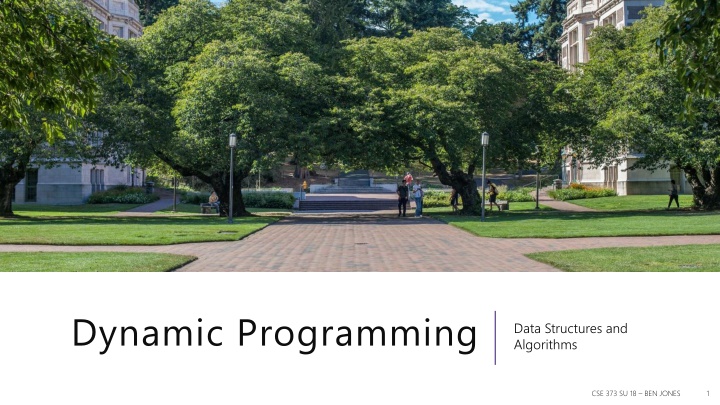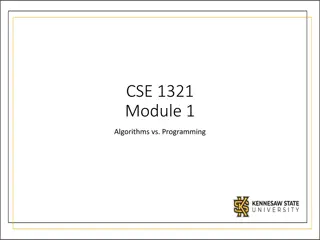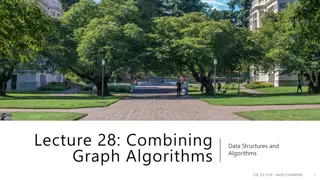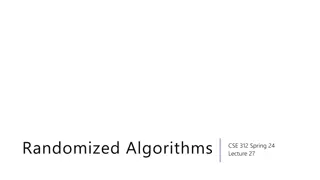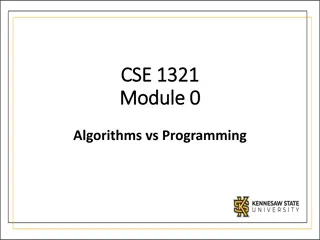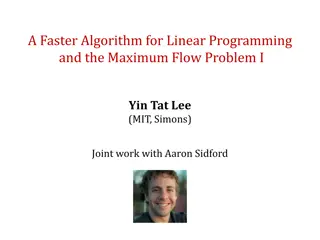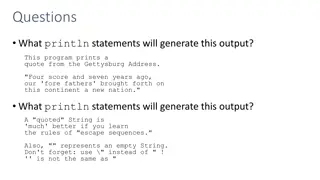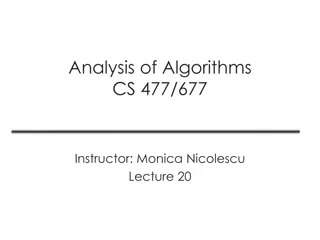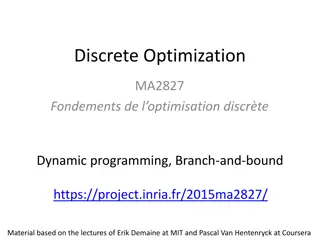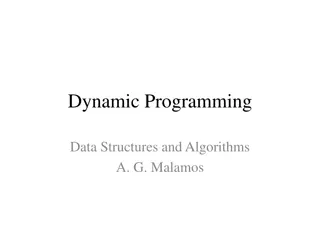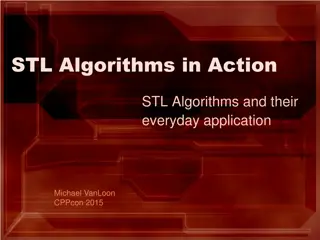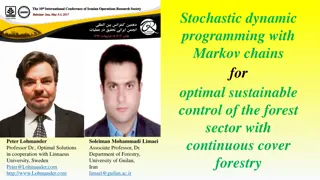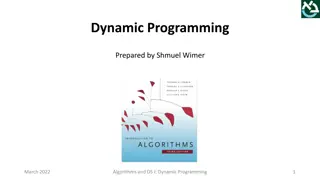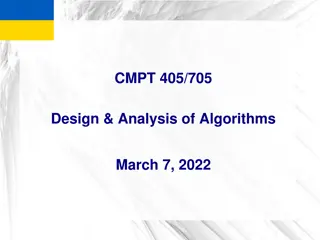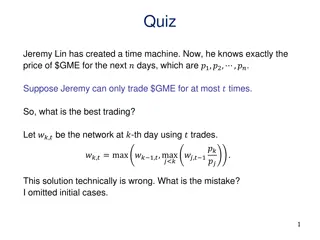Dynamic Programming and Algorithms Overview
This collection of images covers various topics in dynamic programming, data structures, and algorithms. Explore minimum spanning tree algorithms, Fibonacci numbers, and memoization techniques. Understand the concepts behind Kruskal's and Prim's algorithms, as well as the importance of memoization in optimizing algorithm performance.
Download Presentation

Please find below an Image/Link to download the presentation.
The content on the website is provided AS IS for your information and personal use only. It may not be sold, licensed, or shared on other websites without obtaining consent from the author.If you encounter any issues during the download, it is possible that the publisher has removed the file from their server.
You are allowed to download the files provided on this website for personal or commercial use, subject to the condition that they are used lawfully. All files are the property of their respective owners.
The content on the website is provided AS IS for your information and personal use only. It may not be sold, licensed, or shared on other websites without obtaining consent from the author.
E N D
Presentation Transcript
Dynamic Programming Data Structures and Algorithms CSE 373 SU 18 BEN JONES 1
Warmup Find a minimum spanning tree for the following graph: CSE 373 SU 18 BEN JONES 2
With Kruskals Algorithm Find a minimum spanning tree for the following graph: CSE 373 SU 18 BEN JONES 3
With Primms Algorithm Vertex Vertex Known Known D D P P Find a minimum spanning tree for the following graph: A B C D E F CSE 373 SU 18 BEN JONES 4
Dynamic Programming When the greedy approach fails. CSE 373 SU 18 BEN JONES 5
Fibonacci Numbers 1, 1, 2, 3, 5, 8, 13, fib(n) = fib(n-1) + fib(n-2) fib(0) = fib(1) = 1 CSE 373 SU 18 BEN JONES 6
Fibonacci Numbers public int fib(int i) { int result; if (i < 2) { result = 1; } else { result = fibonacci(i - 1) + fibonacci(i - 2); } return result; } What is the runtime of this algorithm? What is the runtime of this algorithm? CSE 373 SU 18 BEN JONES 7
Fibonacci Numbers fib(10) fib(9) fib(8) fib(8) fib(7) fib(7) fib(6) fib(7) fib(6) fib(6) fib(5) fib(6) fib(5) fib(5) fib(4) CSE 373 SU 18 BEN JONES 8
Fibonacci Numbers: By Hand n 0 1 2 3 4 5 6 7 8 9 10 11 12 fib(n) We did this by hand in much less than exponential time. How? We looked up previous results in the table, re-using past computation. Big Idea: Keep an array of sub sub- -problem solutions problem solutions, use it to avoid re-computing results! CSE 373 SU 18 BEN JONES 9
Memoization Memoization is storing the results of a deterministic deterministic function in a table to use later: If f(n) f(n) is a deterministic function (from ints to ints): memo = Integer [N] // N is the biggest input we care about memoized_f(n) { if (memo[n] == null) { memo[n] = f(n); } return memo[n]; } CSE 373 SU 18 BEN JONES 10
Memoized Fibonacci memo = int[N]; // initialized to all 0s use as sentinels since fib(n) > 0 for all n public int fib(int i) { if (memo[i] <= 0) { if (i < 2) { memo[i] = 1; } else { memo[i] = fib(i - 1) + fib(i - 2); } } return memo[i] } CSE 373 SU 18 BEN JONES 11
Dynamic Programming Breaking down a problem into smaller subproblems that are more easily solved. Differs from divide and conquer in that subproblem solutions are re-used (not independent) - Ex: Merge sort: Memoization is such a problem is sometimes called top-down dynamic programming. If this is top-down, what is bottom up? CSE 373 SU 18 BEN JONES 12
Top Down Evaluation Which order to we call fib(n) in? Which order are the table cells filled in? n 0 1 2 3 4 5 6 7 8 9 10 11 12 fib(n) In bottom-up dynamic programming (sometimes just called dynamic programming), we figure out ahead of time what order the table entries need to be filled, and solve the subproblems in that order from the start! CSE 373 SU 18 BEN JONES 13
Fibonacci Bottom Up public int fib(int n) { fib = new int[n]; fib[0] = fib[1] = 1; for (int i = 2; i < n; ++i) { fib[i] = fib[i - 1] + fib[i - 2]; } return fib[n]; } // Base cases: pre // Base cases: pre- -fill the table fill the table // Loop order is important: non // Loop order is important: non- -base cases in order of fill // Recursive case: looks just like a recurrence // Recursive case: looks just like a recurrence base cases in order of fill Pros: Pros: Runs faster Won t build up a huge call stack Easier to analyze runtime Cons Cons More difficult to write CSE 373 SU 18 BEN JONES 14
An Optimization We only ever need the previous two results, so we can throw out the rest of the array. public int fib(int n) { fib = new int[2]; fib[0] = fib[1] = 1; for (int i = 2; i < n; ++i) { fib[i % 2] = fib[0] + fib[1]; } return fib[n%2]; } Now we can solve for arbitrarily high Fibonacci numbers using finite memory! Now we can solve for arbitrarily high Fibonacci numbers using finite memory! CSE 373 SU 18 BEN JONES 15
Another Example Here s a recurrence you could imagine seeing on the final. What if you want to numerically check your solution? ? 1 ? ? =2 ? ?=0 ? ? + ? ? 0 = 1 CSE 373 SU 18 BEN JONES 16
Recursively What does the call tree look like for this? public static double eval(int n) { if (n == 0 ) { return 1.0; } else { double sum = 0.0; for (int i = 0; i < n; i++) { sum += eval( i ); return 2.0 * sum / n + n; } } With your neighbor: Try writing a bottom-up dynamic program for this computation. CSE 373 SU 18 BEN JONES 17
With Dynamic Programming CSE 373 SU 18 BEN JONES 18
With Dynamic Programming public static double eval( int n ) { double[] c = new double[n + 1]; // n + 1 is pretty common to allow a 0 case // n + 1 is pretty common to allow a 0 case c[0] = 1.0; for (int i = 1; i <= n; ++i) { // Loop bounds in DP look different, not always 0 < x < last // Loop bounds in DP look different, not always 0 < x < last double sum = 0.0; for (int j = 0; j < i; j++) { sum += c[j]; } c[i] = 2.0 * sum / i + i; } return c[n]; } CSE 373 SU 18 BEN JONES 19
Where is Dynamic Programming Used These examples were a bit contrived. Dynamic programming is very useful for optimization - Brute force for these problems is often exponential or worse. DP can often achieve polynomial time. optimization problems and counting counting problems. Examples: How many ways can I tile a floor? How many ways can I make change? * What is the most efficient way to make change? * Find the best insertion order for a BST when lookup probabilities are known. All shortest paths is a graph. * CSE 373 SU 18 BEN JONES 20
Coin Changing Problem (1) THIS IS A VERY COMMON INTERVIEW QUESTION! THIS IS A VERY COMMON INTERVIEW QUESTION! Problem: I have an unlimited set of coins of denomitations w[0], w[1], w[2], I need to make change for W cents. How can I do this using the minimum number of coins? Example: I have pennies w[0] = 1, nickels w[1] = 5, dimes w[2] = 10, and quarters w[3] = 25, and I need to make change for 37 cents. I could use 37 pennies (37 coins), 3 dimes + 1 nickels + 2 pennies (6 coins), but the optimal solution is 1 quarter + 1 dime + 2 pennies (5 coins). We want an algorithm to efficiently compute the best solution for any problem instance. We want an algorithm to efficiently compute the best solution for any problem instance. CSE 373 SU 18 BEN JONES 21
